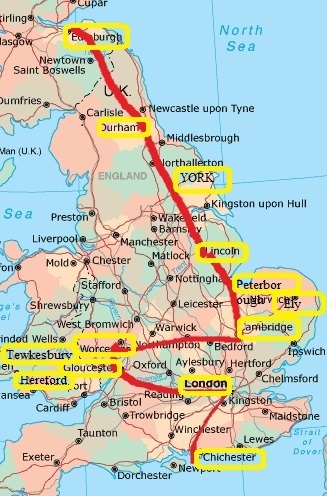U.K. 2013

Day 15, Tuesday
September 17, 2013
Tewkesbury and Gloucester
We had to catch a 9:00 train this morning, so we got up at 6:30. We had
a hard time getting ready because this hotel has a fancy, complicated
control box for the shower. We couldn’t seem to adjust it correctly so
we were either too hot or too cold. The breakfast buffet (our first
here) was kind of skimpy. There was an assortment of cereal and a few
pastries. Other things could be ordered from the menu. As we remember
from our 2003 trip, the
English eat "different" things for breakfast
like blood pudding, baked beans and tomatoes to name a few.
The sun was shining for once; we took at taxi to the train station for
the train to Tewkesbury. It was a 35 minute train ride. When we got
off there was no station building or taxies …sort of out in the middle
of nowhere except for a few business type building. There were sign for
a bus stop,but no bus-a little
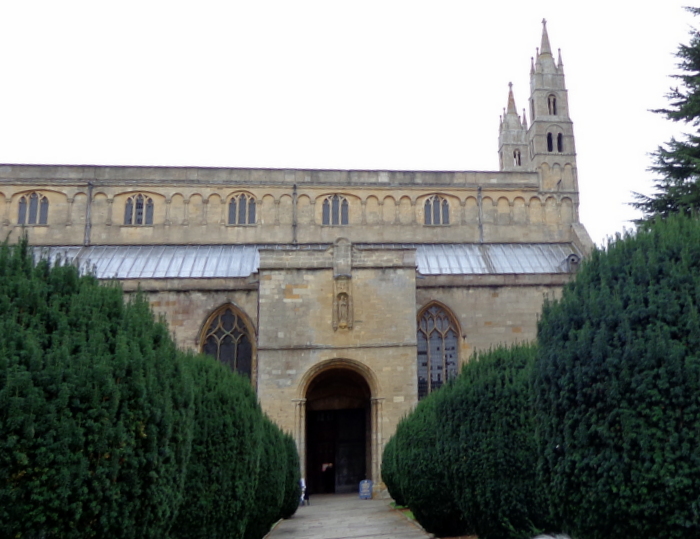 scary.
We finally found a taxi which took us to the Tewkesbury Abbey.
scary.
We finally found a taxi which took us to the Tewkesbury Abbey.
One of the reasons we chose to go to Tewkesbury Abbey is that I made a
model of it. The model is a lovely building and we wanted to see it in
person. SEE MY MODEL.
Upon entering church,we went to
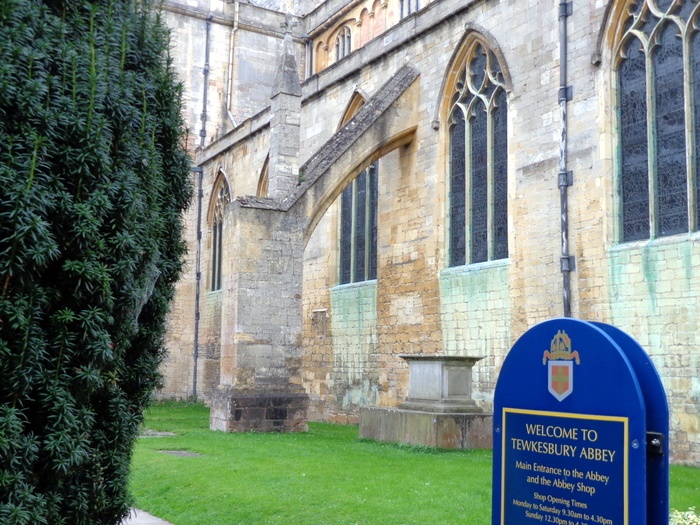 the
bookstore to get our tour. One of ladies had been in D.C. recently.
They were confused because they thought that we were coming at noon for
a tour with the Vicar. I had an email on my phone that said we were
having a 10:00 tour. They said they would get someone to give us a tour
but in the meantime go to their tea room and have a cup of coffee. We
hadn’t had coffee this morning.
the
bookstore to get our tour. One of ladies had been in D.C. recently.
They were confused because they thought that we were coming at noon for
a tour with the Vicar. I had an email on my phone that said we were
having a 10:00 tour. They said they would get someone to give us a tour
but in the meantime go to their tea room and have a cup of coffee. We
hadn’t had coffee this morning.
Presently, the lady that we had talked to, brought a man over who was a
tour guide. He was a retired head master of a school. He gave us a
wonderful two hour tour. He was extremely knowledgeable, quite humorous
and told wonderful stories.
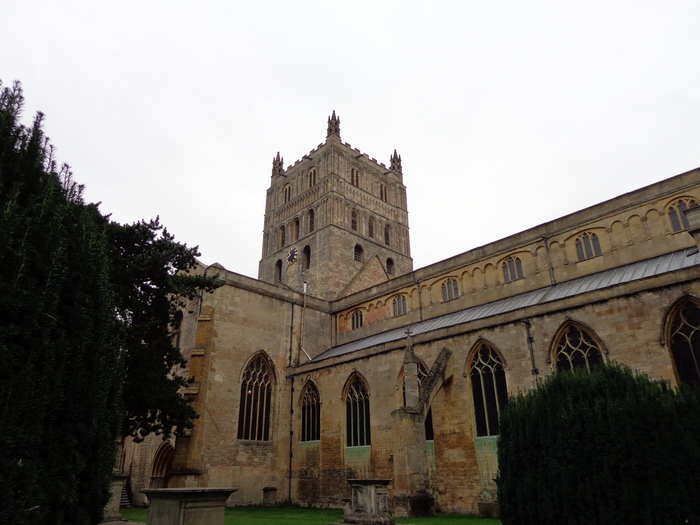 Tewkesbury
Abby a very good example of Norman architecture. It was started in 1102
to house Benedictine monks. Embellishments were made in the first half
of the 14th century in the Decorated style. After the Dissolution of
the Abbey by Henry VIII, some of it was destroyed. It later became a
parish church, which it continues to be to this day.
Tewkesbury
Abby a very good example of Norman architecture. It was started in 1102
to house Benedictine monks. Embellishments were made in the first half
of the 14th century in the Decorated style. After the Dissolution of
the Abbey by Henry VIII, some of it was destroyed. It later became a
parish church, which it continues to be to this day.
The tower, completed in the latter half of the 12th century, is the
largest and finest Romane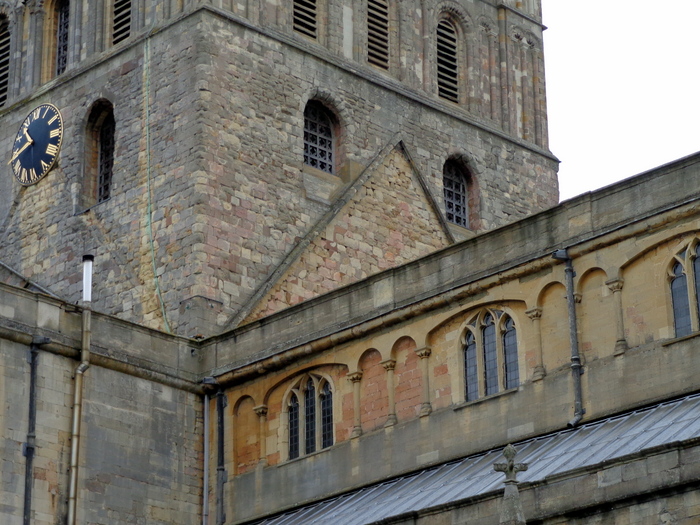 sque
tower in England.
sque
tower in England.
Note the photo at the right where evidence of a former pitched roof had
been. There were a large number of beautiful windows and well as a
fantastic ceiling.
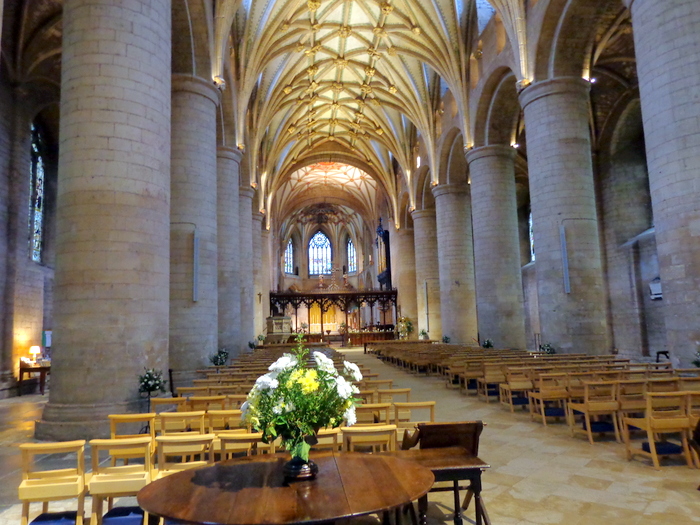
The nave, looking east, is dominated by great Norman columns, each more
than 30 feet high and over 6 feet in diameter and surmounted by a
Romanesque arches. Above the arches is a triforium .
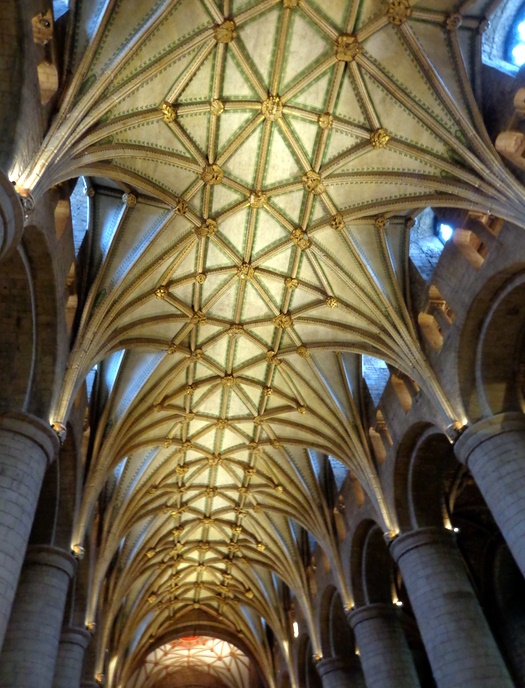
The great vault of 1340 replaced a flat wooden ceiling. The 15
bosses of the central rib tell the story of the life of Jesus. The
bosses of the subsidiary ribs on either side feature angels playing
medieval musical instruments.
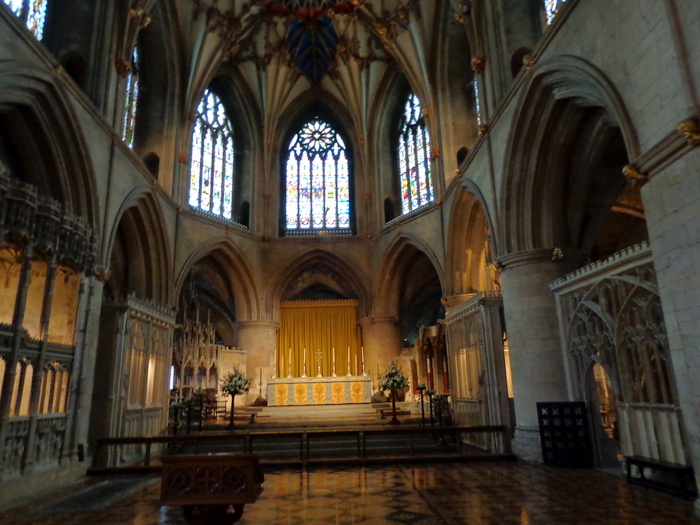
Tewkesbury Abby bears a significant resemblance to its sister Church of
St. Peter's, Gloucester in the nave elevation and the ambulatory plan.
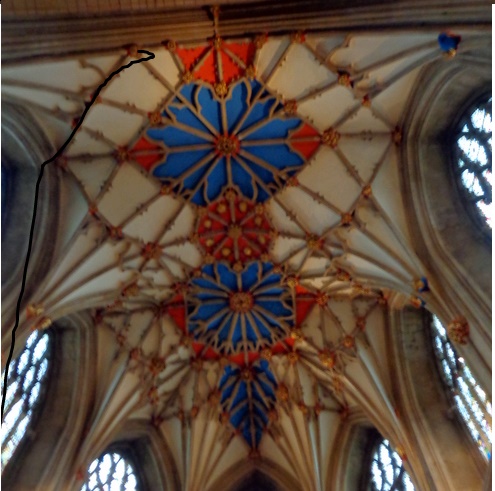
Above the high altar at the East end and the Norman choir is a colorful
14th-century stellar vault, painted and gilded, and later decorated with
the York issued badges of the sun in splendor.
On the south side of the nave, there are the remains of the 15th century
cloister. The pillars of the choir, originally as tall as those of the
nave, were cut down to half their height in the 14th century
reconstruction.
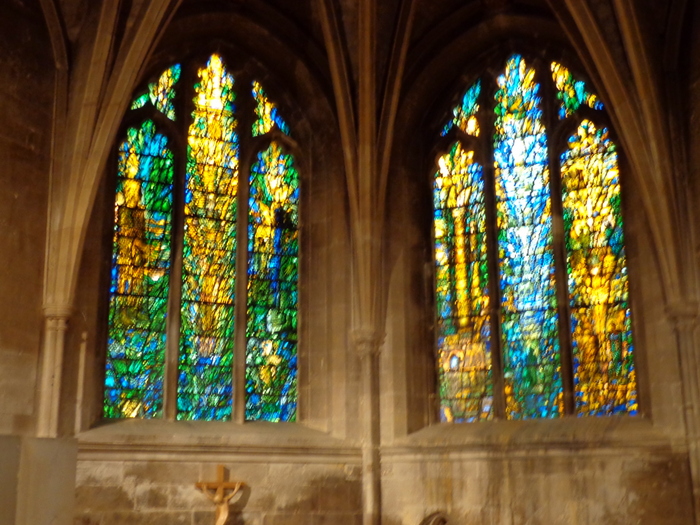
The most recent stained-glass is that found in the Chapel of St.
Catherine and St. John the Baptist. This was created by Tom Denny for
the 900th anniversary of the monks first arriving at the Abbey. The
theme of the two windows is the Benedictine motto "to work is to pray."
We certainly are glad that we had chosen to visit this lovely church.
Our thanks goes to Rupert Cordeaux who has produced the model kits for
most of the English Cathedrals and a few of the non-Cathedral churches
and abbeys. If I had not purchased and made this lovely model, we would
have missed a very inspiring visit to Tewkesbury Abby.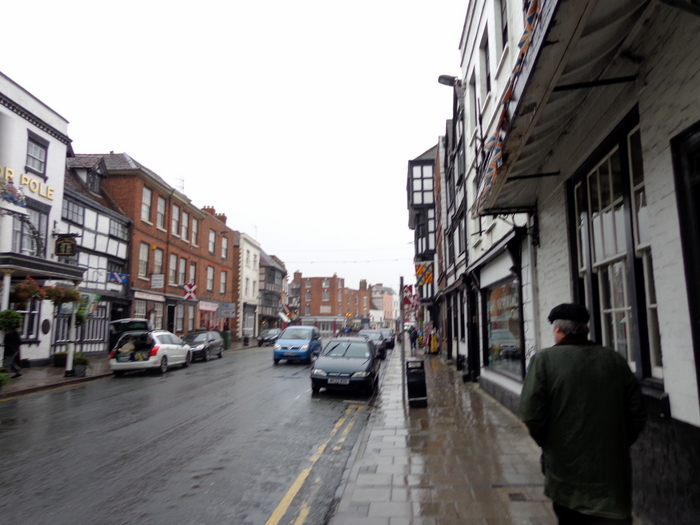
About noon, the Vicar showed
up to greet us. After a little time with him, we needed to go several
blocks away to catch a bus to Gloucester. He said he would show us the
way. When we came out of the Abbey, it was pouring (what else is
new?). He walked us to the bus stop anyhow. What a kind man.
The bus ride, in the rain, took about 30 minutes to Gloucester.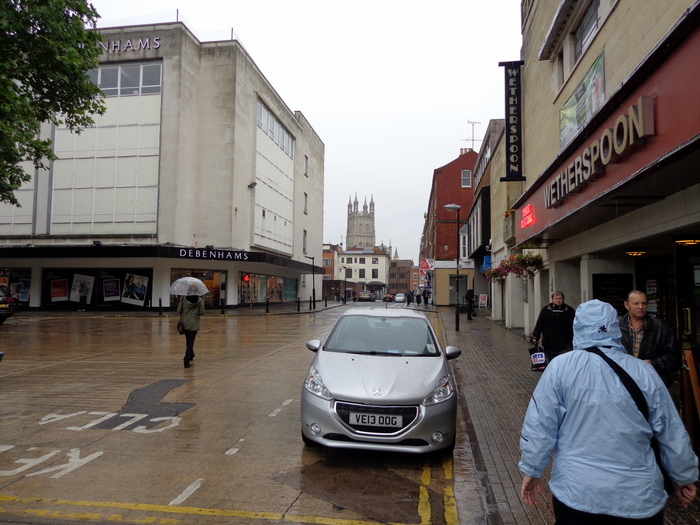 I
have a Rupert Cordeaux model of Gloucester Cathedral but I have not made
it. We
stopped at the bus station and walked about 10 minutes to the
cathedral. It was drizzling some, windy and very cold. We were greeted
at the door by a lady who had just return to Gloucester from Washington,
Baltimore, and Boston. We had 2:30 appointment for a tour so we had over
an hour to rest and refuel. They had a nice tea room, so we had a
sandwich, chips and a piece of cake. We met our guide, Pat, who gave us
a extremely interesting tour.
I
have a Rupert Cordeaux model of Gloucester Cathedral but I have not made
it. We
stopped at the bus station and walked about 10 minutes to the
cathedral. It was drizzling some, windy and very cold. We were greeted
at the door by a lady who had just return to Gloucester from Washington,
Baltimore, and Boston. We had 2:30 appointment for a tour so we had over
an hour to rest and refuel. They had a nice tea room, so we had a
sandwich, chips and a piece of cake. We met our guide, Pat, who gave us
a extremely interesting tour.
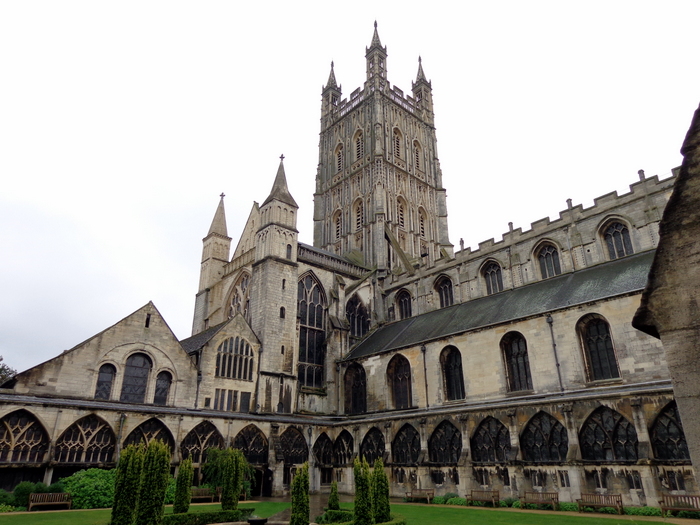 Following the Norman invasion of England, William the Conqueror
appointed Serlo, a monk from Mont St. Michel in Western Normandy, as
Abbott of Gloucester in 1072. Serlo set about planning the building of
a new Abbey in the Romanesque style, which was consecrated in 1100.
Following the Norman invasion of England, William the Conqueror
appointed Serlo, a monk from Mont St. Michel in Western Normandy, as
Abbott of Gloucester in 1072. Serlo set about planning the building of
a new Abbey in the Romanesque style, which was consecrated in 1100.
Gloucester's magnificent tower is 220 feet tall and is visible from
miles around. It was built from 1450 to 1457.
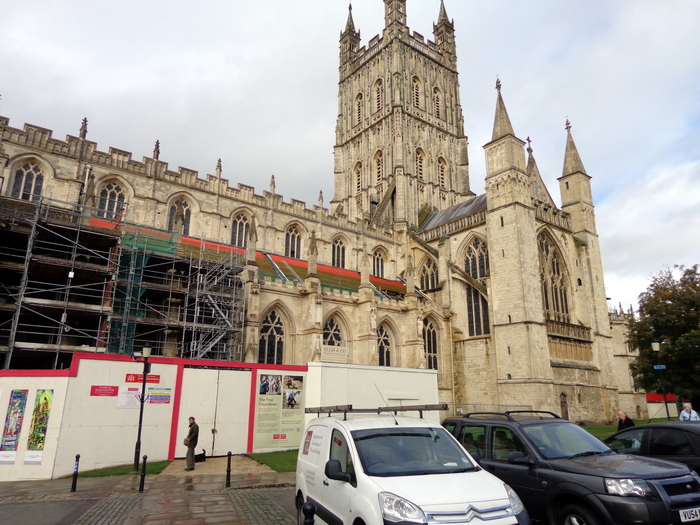 Gloucester is one of the six former abbeys refounded as cathedrals
under King Henry VIII. From 1089 up to the Reformation in 1540, it was
a Benedictine monastery dedicated to St. Peter.
Gloucester is one of the six former abbeys refounded as cathedrals
under King Henry VIII. From 1089 up to the Reformation in 1540, it was
a Benedictine monastery dedicated to St. Peter.
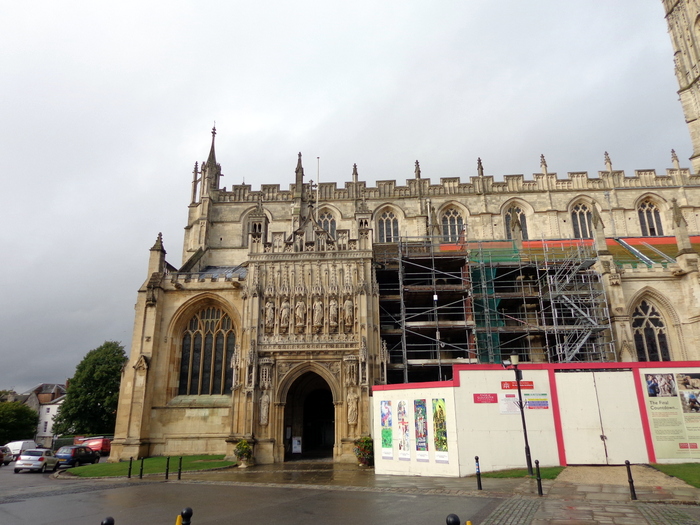
The main entrance to the Cathedral is the south porch, which dates from
the early 15th-century. It underwent restoration around 1870.
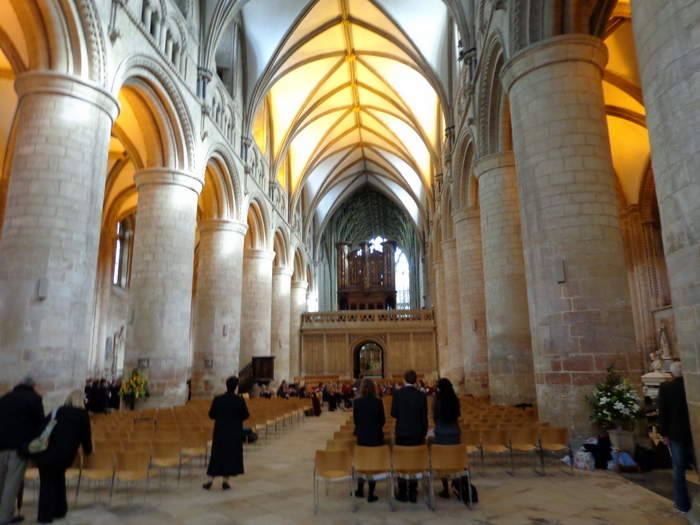 The nave dates from the last years of the 11th century and is an
outstanding example of Romanesque building. The vast cylindrical Norman
columns, 32 feet high and 6 feet in diameter – very similar to those
that we just saw at Tewkesbury – carry an arcade of narrow arches above
which is a relatively low triforium and clerestory. During the 1420s
two of the most westerly bays were rebuilt in perpendicular style.
The nave dates from the last years of the 11th century and is an
outstanding example of Romanesque building. The vast cylindrical Norman
columns, 32 feet high and 6 feet in diameter – very similar to those
that we just saw at Tewkesbury – carry an arcade of narrow arches above
which is a relatively low triforium and clerestory. During the 1420s
two of the most westerly bays were rebuilt in perpendicular style.
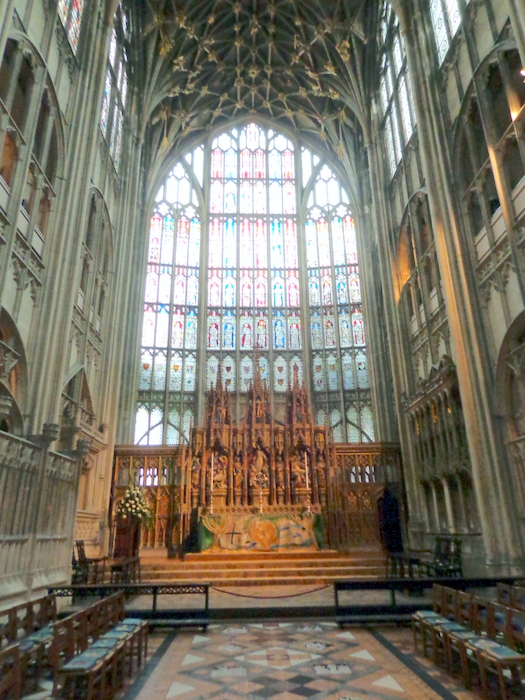
The window behind the high altar is the second largest window in area of
medieval stained glass in any British church. It measures 72' high
and 38' wide.
The floor gold color tile floor in front of the altar is similar to the
floor at Tewkesbury
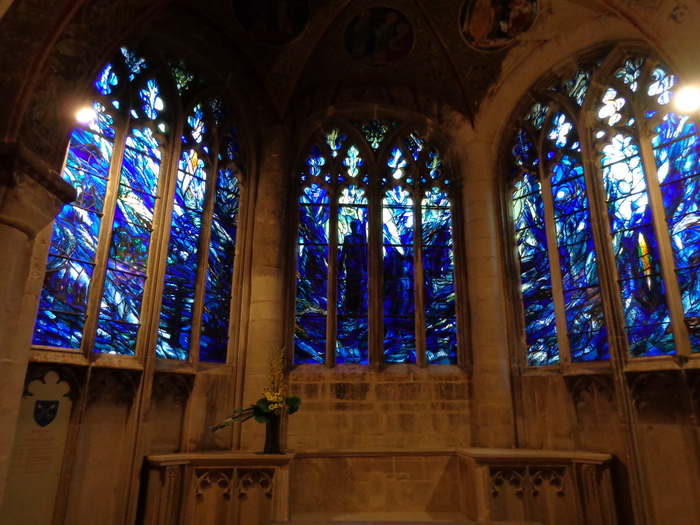 As part of the 900th anniversary celebration of
Serlo' s foundation in 1089, the South ambulatory Chapel was refitted
with a new altar, seating and a new stained-glass window by Tom Denny
portraying the New Testament story of Thomas in the presence of the
risen Christ. This is the same Tom Denny who designed the modern window
in Tewkesbury Abby which we saw earlier today.
As part of the 900th anniversary celebration of
Serlo' s foundation in 1089, the South ambulatory Chapel was refitted
with a new altar, seating and a new stained-glass window by Tom Denny
portraying the New Testament story of Thomas in the presence of the
risen Christ. This is the same Tom Denny who designed the modern window
in Tewkesbury Abby which we saw earlier today.
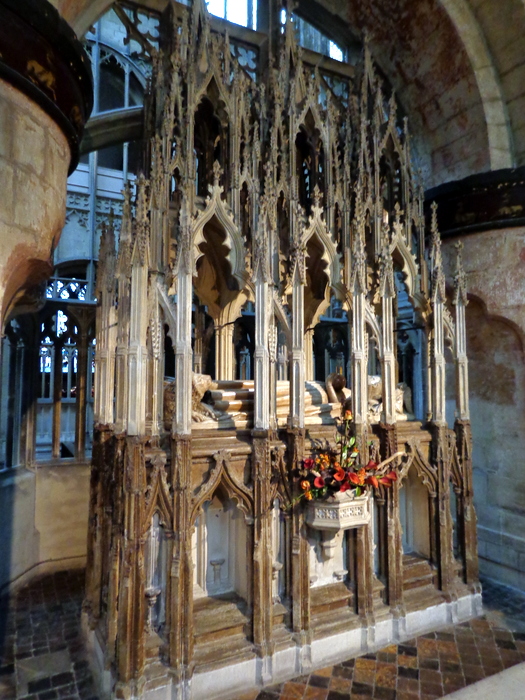
Along the north
ambulatory is the tomb of King Edward II.
King Edward was born in 1284 and reigned from 1307 to 1327. For
over 70 years, it was a site of special pilgrimages.
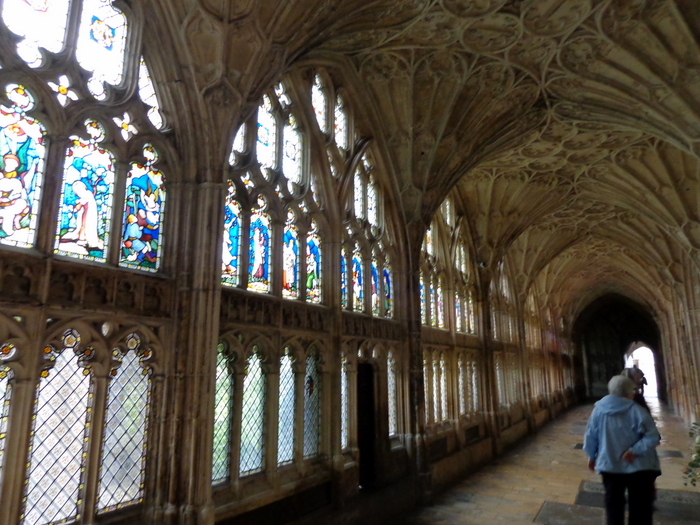 Gloucester's great cloister is famous for its magnificent fan
vaulting above all four of its walks. Begun in the latter half of the
14th century and finished before 1412, it replace the Norman cloister.
The design incorporated a row of 20 cubicles along the sidewalk; each
had a wooden desk, which the monks used for study. Along the west end
of the North walk was the washing place which made use of the local
stream. Two of the Harry Potter books were filmed using these cloisters.
Gloucester's great cloister is famous for its magnificent fan
vaulting above all four of its walks. Begun in the latter half of the
14th century and finished before 1412, it replace the Norman cloister.
The design incorporated a row of 20 cubicles along the sidewalk; each
had a wooden desk, which the monks used for study. Along the west end
of the North walk was the washing place which made use of the local
stream. Two of the Harry Potter books were filmed using these cloisters.
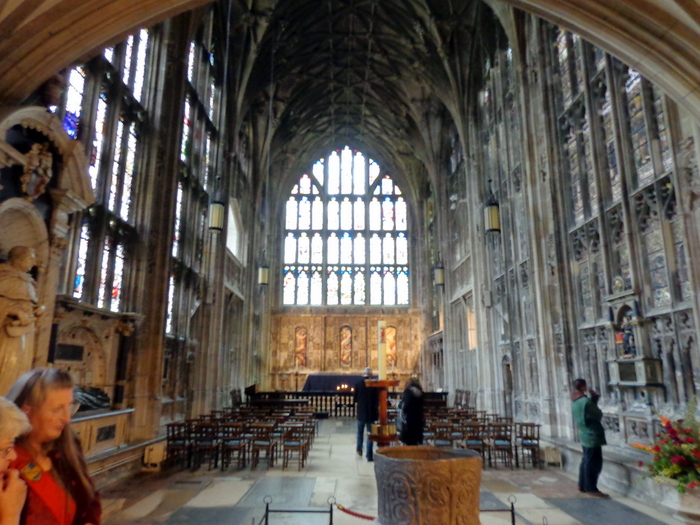
Leading off the ambulatory at the East End is the Lady Chapel, the last
part of the church to be built in the medieval style. It has vaulted
roof on a series of stone arches filled with stained-glass windows.
We even went down into the crypt,
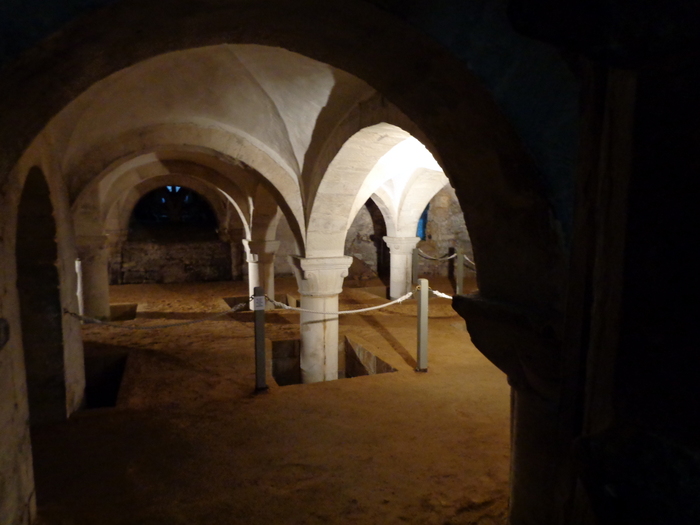 which in contains the earliest Norman
work. There is a central area, which is beneath the choir and a walkway
all around it from which five chapels open out. We had another
wonderful tour of the magnificent Cathedral with a very knowledgeable
guide. Thank you, Pat.
which in contains the earliest Norman
work. There is a central area, which is beneath the choir and a walkway
all around it from which five chapels open out. We had another
wonderful tour of the magnificent Cathedral with a very knowledgeable
guide. Thank you, Pat.
We left about 5:00 pm and walked to the train station which was about a
block from the bus station. It took about 40 minutes to get back to
Worchester. Again a taxi ride back to our hotel. We were tired and
cold so we decided to eat there again. We split a dinner. Kathleen had
soup for a starter. I just had Jack Daniel. We shared a small stuffed
pork tenderloin wrapped in bacon and a potato cake. Both were
delicious.

 scary.
We finally found a taxi which took us to the Tewkesbury Abbey.
scary.
We finally found a taxi which took us to the Tewkesbury Abbey.  the
bookstore to get our tour. One of ladies had been in D.C. recently.
They were confused because they thought that we were coming at noon for
a tour with the Vicar. I had an email on my phone that said we were
having a 10:00 tour. They said they would get someone to give us a tour
but in the meantime go to their tea room and have a cup of coffee. We
hadn’t had coffee this morning.
the
bookstore to get our tour. One of ladies had been in D.C. recently.
They were confused because they thought that we were coming at noon for
a tour with the Vicar. I had an email on my phone that said we were
having a 10:00 tour. They said they would get someone to give us a tour
but in the meantime go to their tea room and have a cup of coffee. We
hadn’t had coffee this morning.  Tewkesbury
Abby a very good example of Norman architecture. It was started in 1102
to house Benedictine monks. Embellishments were made in the first half
of the 14th century in the Decorated style. After the Dissolution of
the Abbey by Henry VIII, some of it was destroyed. It later became a
parish church, which it continues to be to this day.
Tewkesbury
Abby a very good example of Norman architecture. It was started in 1102
to house Benedictine monks. Embellishments were made in the first half
of the 14th century in the Decorated style. After the Dissolution of
the Abbey by Henry VIII, some of it was destroyed. It later became a
parish church, which it continues to be to this day.  sque
tower in England.
sque
tower in England. 
 I
have a Rupert Cordeaux model of Gloucester Cathedral but I have not made
it. We
stopped at the bus station and walked about 10 minutes to the
cathedral. It was drizzling some, windy and very cold. We were greeted
at the door by a lady who had just return to Gloucester from Washington,
Baltimore, and Boston. We had 2:30 appointment for a tour so we had over
an hour to rest and refuel. They had a nice tea room, so we had a
sandwich, chips and a piece of cake. We met our guide, Pat, who gave us
a extremely interesting tour.
I
have a Rupert Cordeaux model of Gloucester Cathedral but I have not made
it. We
stopped at the bus station and walked about 10 minutes to the
cathedral. It was drizzling some, windy and very cold. We were greeted
at the door by a lady who had just return to Gloucester from Washington,
Baltimore, and Boston. We had 2:30 appointment for a tour so we had over
an hour to rest and refuel. They had a nice tea room, so we had a
sandwich, chips and a piece of cake. We met our guide, Pat, who gave us
a extremely interesting tour.  Following the Norman invasion of England, William the Conqueror
appointed Serlo, a monk from Mont St. Michel in Western Normandy, as
Abbott of Gloucester in 1072. Serlo set about planning the building of
a new Abbey in the Romanesque style, which was consecrated in 1100.
Following the Norman invasion of England, William the Conqueror
appointed Serlo, a monk from Mont St. Michel in Western Normandy, as
Abbott of Gloucester in 1072. Serlo set about planning the building of
a new Abbey in the Romanesque style, which was consecrated in 1100. Gloucester is one of the six former abbeys refounded as cathedrals
under King Henry VIII. From 1089 up to the Reformation in 1540, it was
a Benedictine monastery dedicated to St. Peter.
Gloucester is one of the six former abbeys refounded as cathedrals
under King Henry VIII. From 1089 up to the Reformation in 1540, it was
a Benedictine monastery dedicated to St. Peter.  The nave dates from the last years of the 11th century and is an
outstanding example of Romanesque building. The vast cylindrical Norman
columns, 32 feet high and 6 feet in diameter – very similar to those
that we just saw at Tewkesbury – carry an arcade of narrow arches above
which is a relatively low triforium and clerestory. During the 1420s
two of the most westerly bays were rebuilt in perpendicular style.
The nave dates from the last years of the 11th century and is an
outstanding example of Romanesque building. The vast cylindrical Norman
columns, 32 feet high and 6 feet in diameter – very similar to those
that we just saw at Tewkesbury – carry an arcade of narrow arches above
which is a relatively low triforium and clerestory. During the 1420s
two of the most westerly bays were rebuilt in perpendicular style.  As part of the 900th anniversary celebration of
Serlo' s foundation in 1089, the South ambulatory Chapel was refitted
with a new altar, seating and a new stained-glass window by Tom Denny
portraying the New Testament story of Thomas in the presence of the
risen Christ. This is the same Tom Denny who designed the modern window
in Tewkesbury Abby which we saw earlier today.
As part of the 900th anniversary celebration of
Serlo' s foundation in 1089, the South ambulatory Chapel was refitted
with a new altar, seating and a new stained-glass window by Tom Denny
portraying the New Testament story of Thomas in the presence of the
risen Christ. This is the same Tom Denny who designed the modern window
in Tewkesbury Abby which we saw earlier today.  Gloucester's great cloister is famous for its magnificent fan
vaulting above all four of its walks. Begun in the latter half of the
14th century and finished before 1412, it replace the Norman cloister.
The design incorporated a row of 20 cubicles along the sidewalk; each
had a wooden desk, which the monks used for study. Along the west end
of the North walk was the washing place which made use of the local
stream. Two of the Harry Potter books were filmed using these cloisters.
Gloucester's great cloister is famous for its magnificent fan
vaulting above all four of its walks. Begun in the latter half of the
14th century and finished before 1412, it replace the Norman cloister.
The design incorporated a row of 20 cubicles along the sidewalk; each
had a wooden desk, which the monks used for study. Along the west end
of the North walk was the washing place which made use of the local
stream. Two of the Harry Potter books were filmed using these cloisters.
